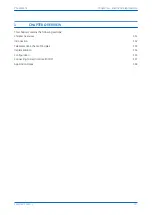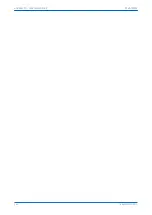
3
SERIAL COMMUNICATION
The physical layer standards that are used for serial communications for SCADA purposes are:
●
EIA(RS)485 (often abbreviated to RS485)
●
K-Bus (a proprietary customization of RS485)
EIA(RS)232 is used for local communication with the IED (for transferring settings and downloading firmware
updates).
RS485 is similar to RS232 but for longer distances and it allows daisy-chaining and multi-dropping of IEDs.
K-Bus is a proprietary protocol quite similar to RS485, but it cannot be mixed on the same link as RS485. Unlike
RS485, K-Bus signals applied across two terminals are not polarised.
It is important to note that these are not data protocols. They only describe the physical characteristics required
for two devices to communicate with each other.
For a description of the K-Bus standard see
(on page346) and General Electric's K-Bus interface guide
reference R6509.
A full description of the RS485 is available in the published standard.
3.1
EIA(RS)232 BUS
The EIA(RS)232 interface uses the IEC 60870-5 FT1.2 frame format.
The device supports an IEC 60870-5 FT1.2 connection on the front-port. This is intended for temporary local
connection and is not suitable for permanent connection. This interface uses a fixed baud rate of 19200 bps, 11-bit
frame (8 data bits, 1 start bit, 1 stop bit, even parity bit), and a fixed device address of '1'.
EIA(RS)232 interfaces are polarised.
3.2
EIA(RS)485 BUS
The RS485 two-wire connection provides a half-duplex, fully isolated serial connection to the IED. The connection is
polarized but there is no agreed definition of which terminal is which. If the master is unable to communicate with
the product, and the communication parameters match, then it is possible that the two-wire connection is
reversed.
The RS485 bus must be terminated at each end with 120 Ω 0.5 W terminating resistors between the signal wires.
The RS485 standard requires that each device be directly connected to the actual bus. Stubs and tees are
forbidden. Loop bus and Star topologies are not part of the RS485 standard and are also forbidden.
Two-core screened twisted pair cable should be used. The final cable specification is dependent on the application,
although a multi-strand 0.5 mm
2
per core is normally adequate. The total cable length must not exceed 1000 m. It
is important to avoid circulating currents, which can cause noise and interference, especially when the cable runs
between buildings. For this reason, the screen should be continuous and connected to ground at one end only,
normally at the master connection point.
The RS485 signal is a differential signal and there is no signal ground connection. If a signal ground connection is
present in the bus cable then it must be ignored. At no stage should this be connected to the cable's screen or to
the product’s chassis. This is for both safety and noise reasons.
It may be necessary to bias the signal wires to prevent jabber. Jabber occurs when the signal level has an
indeterminate state because the bus is not being actively driven. This can occur when all the slaves are in receive
mode and the master is slow to turn from receive mode to transmit mode. This may be because the master is
waiting in receive mode, in a high impedance state, until it has something to transmit. Jabber causes the receiving
device(s) to miss the first bits of the first character in the packet, which results in the slave rejecting the message
and consequently not responding. Symptoms of this are; poor response times (due to retries), increasing message
error counts, erratic communications, and in the worst case, complete failure to communicate.
P54A/B/C/E
Chapter 17 - Communications
P54xMED-TM-EN-1
345
Summary of Contents for P4A
Page 2: ......
Page 20: ...Contents P54A B C E xviii P54xMED TM EN 1 ...
Page 27: ...CHAPTER 1 INTRODUCTION ...
Page 28: ...Chapter 1 Introduction P54A B C E 2 P54xMED TM EN 1 ...
Page 38: ...Chapter 1 Introduction P54A B C E 12 P54xMED TM EN 1 ...
Page 39: ...CHAPTER 2 SAFETY INFORMATION ...
Page 40: ...Chapter 2 Safety Information P54A B C E 14 P54xMED TM EN 1 ...
Page 52: ...Chapter 2 Safety Information P54A B C E 26 P54xMED TM EN 1 ...
Page 53: ...CHAPTER 3 HARDWARE DESIGN ...
Page 54: ...Chapter 3 Hardware Design P54A B C E 28 P54xMED TM EN 1 ...
Page 86: ...Chapter 3 Hardware Design P54A B C E 60 P54xMED TM EN 1 ...
Page 87: ...CHAPTER 4 SOFTWARE DESIGN ...
Page 88: ...Chapter 4 Software Design P54A B C E 62 P54xMED TM EN 1 ...
Page 99: ...CHAPTER 5 CONFIGURATION ...
Page 100: ...Chapter 5 Configuration P54A B C E 74 P54xMED TM EN 1 ...
Page 120: ...Chapter 5 Configuration P54A B C E 94 P54xMED TM EN 1 ...
Page 121: ...CHAPTER 6 CURRENT DIFFERENTIAL PROTECTION ...
Page 122: ...Chapter 6 Current Differential Protection P54A B C E 96 P54xMED TM EN 1 ...
Page 149: ...CHAPTER 7 AUTORECLOSE ...
Page 150: ...Chapter 7 Autoreclose P54A B C E 124 P54xMED TM EN 1 ...
Page 207: ...CHAPTER 8 CB FAIL PROTECTION ...
Page 208: ...Chapter 8 CB Fail Protection P54A B C E 182 P54xMED TM EN 1 ...
Page 219: ...CHAPTER 9 CURRENT PROTECTION FUNCTIONS ...
Page 220: ...Chapter 9 Current Protection Functions P54A B C E 194 P54xMED TM EN 1 ...
Page 244: ...Chapter 9 Current Protection Functions P54A B C E 218 P54xMED TM EN 1 ...
Page 247: ...CHAPTER 10 VOLTAGE PROTECTION FUNCTIONS ...
Page 248: ...Chapter 10 Voltage Protection Functions P54A B C E 222 P54xMED TM EN 1 ...
Page 261: ...CHAPTER 11 FREQUENCY PROTECTION FUNCTIONS ...
Page 262: ...Chapter 11 Frequency Protection Functions P54A B C E 236 P54xMED TM EN 1 ...
Page 268: ...Chapter 11 Frequency Protection Functions P54A B C E 242 P54xMED TM EN 1 ...
Page 269: ...CHAPTER 12 MONITORING AND CONTROL ...
Page 270: ...Chapter 12 Monitoring and Control P54A B C E 244 P54xMED TM EN 1 ...
Page 300: ...Chapter 12 Monitoring and Control P54A B C E 274 P54xMED TM EN 1 ...
Page 301: ...CHAPTER 13 SUPERVISION ...
Page 302: ...Chapter 13 Supervision P54A B C E 276 P54xMED TM EN 1 ...
Page 312: ...Chapter 13 Supervision P54A B C E 286 P54xMED TM EN 1 ...
Page 323: ...CHAPTER 14 DIGITAL I O AND PSL CONFIGURATION ...
Page 324: ...Chapter 14 Digital I O and PSL Configuration P54A B C E 298 P54xMED TM EN 1 ...
Page 336: ...Chapter 14 Digital I O and PSL Configuration P54A B C E 310 P54xMED TM EN 1 ...
Page 337: ...CHAPTER 15 FIBRE TELEPROTECTION ...
Page 338: ...Chapter 15 Fibre Teleprotection P54A B C E 312 P54xMED TM EN 1 ...
Page 354: ...Chapter 15 Fibre Teleprotection P54A B C E 328 P54xMED TM EN 1 ...
Page 355: ...CHAPTER 16 ELECTRICAL TELEPROTECTION ...
Page 356: ...Chapter 16 Electrical Teleprotection P54A B C E 330 P54xMED TM EN 1 ...
Page 366: ...Chapter 16 Electrical Teleprotection P54A B C E 340 P54xMED TM EN 1 ...
Page 367: ...CHAPTER 17 COMMUNICATIONS ...
Page 368: ...Chapter 17 Communications P54A B C E 342 P54xMED TM EN 1 ...
Page 439: ...CHAPTER 18 CYBER SECURITY ...
Page 440: ...Chapter 18 Cyber Security P54A B C E 414 P54xMED TM EN 1 ...
Page 457: ...CHAPTER 19 INSTALLATION ...
Page 458: ...Chapter 19 Installation P54A B C E 432 P54xMED TM EN 1 ...
Page 471: ...CHAPTER 20 COMMISSIONING INSTRUCTIONS ...
Page 472: ...Chapter 20 Commissioning Instructions P54A B C E 446 P54xMED TM EN 1 ...
Page 513: ...CHAPTER 21 MAINTENANCE AND TROUBLESHOOTING ...
Page 514: ...Chapter 21 Maintenance and Troubleshooting P54A B C E 488 P54xMED TM EN 1 ...
Page 530: ...Chapter 21 Maintenance and Troubleshooting P54A B C E 504 P54xMED TM EN 1 ...
Page 531: ...CHAPTER 22 TECHNICAL SPECIFICATIONS ...
Page 532: ...Chapter 22 Technical Specifications P54A B C E 506 P54xMED TM EN 1 ...
Page 558: ...Chapter 22 Technical Specifications P54A B C E 532 P54xMED TM EN 1 ...
Page 559: ...APPENDIX A ORDERING OPTIONS ...
Page 560: ...Appendix A Ordering Options P54A B C E P54xMED TM EN 1 ...
Page 565: ...APPENDIX B SETTINGS AND SIGNALS ...
Page 566: ...Appendix B Settings and Signals P54A B C E P54xMED TM EN 1 ...
Page 790: ...Appendix B Settings and Signals P54A B C E B224 P54xMED TM EN 1 ...
Page 835: ...APPENDIX C WIRING DIAGRAMS ...
Page 836: ...Appendix C Wiring Diagrams P54A B C E P54xMED TM EN 1 ...
Page 849: ......
















































